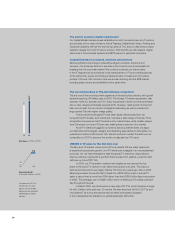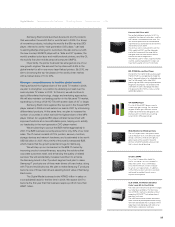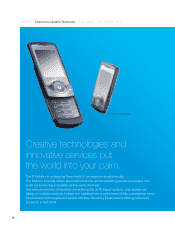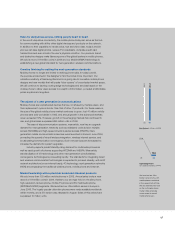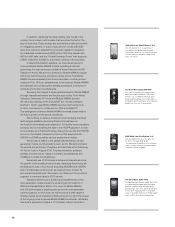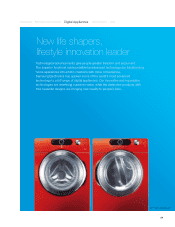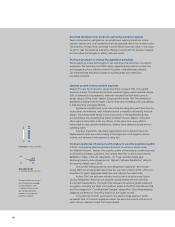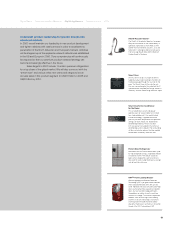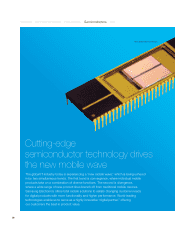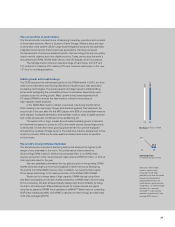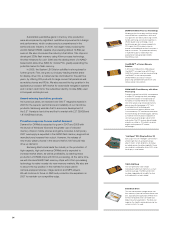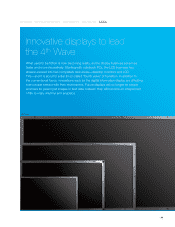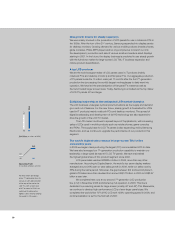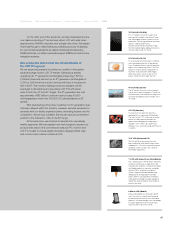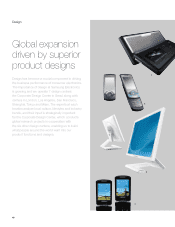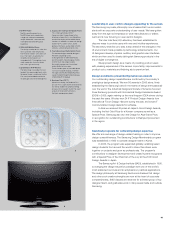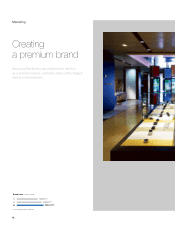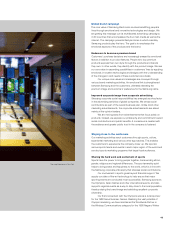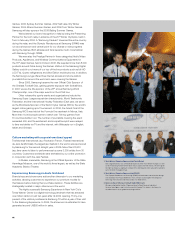Samsung 2006 Annual Report Download - page 44
Download and view the complete annual report
Please find page 44 of the 2006 Samsung annual report below. You can navigate through the pages in the report by either clicking on the pages listed below, or by using the keyword search tool below to find specific information within the annual report.
34
Substantial quantitative gains in memory chip production
were accompanied by significant qualitative improvements in design
and performance, which underscored our preeminence in the
semiconductor industry. In 2006, we began mass producing the
world’s fastest DRAM, capable of processing data at 12.8Gb per
second. We also introduced the industry’s first 50nm 1Gb chip and
developed 32Gb flash memory using 40nm process technology.
Another milestone for us in 2006 was the development of a NAND-
based solid-state drive (SSD) for mobile PCs, greatly expanding the
potential market for flash memory.
In 2006, the System LSI Division solidified a strong base for
further growth. First, we grew our industry-leading market share
for display driver ICs, a market we has dominated for the past five
years, by offering DDI products for large-screen flat panels as well
as mobile phones and PDAs. We also secured the top position in the
application processor (AP) market for automobile navigation systems
and in smart card ICs for the subscriber identity module (SIM) used
in European mobile phones.
Award-winning hard drive products
As in previous years, we received over 500 IT magazine awards in
2006 for the superior performance and reliability of our hard drive
products. Samsung was also first to announce development of
the 3.5˝ 1-terabyte hard drive and first to market with 2.5˝ 250GB and
1.8˝ 80GB hard drives.
Proactive response to new market demand
Demand for DRAMs is expected to grow in 2007 and 2008 with
the launch of Windows Vista and the greater use of onboard
memory chips in mobile phones and game consoles. A temporary
2007 oversupply is expected in the NAND flash memory segment as
manufacturers increase their output. However, the release of
new music-player phones in the second half of 2007 should help
drive up demand.
Samsung Electronics leads the industry in the production of
high-capacity, high-performance DRAMs and is expected to
increase market share, as well as profitability, by starting mass
production of DRAM chips with 60nm processing. At the same time,
we will introduce NAND flash memory chips with 50nm processing
technology to make inroads into new memory markets. We also aim
to secure the top position in the markets for chips used in
camera-equipped phones, image sensors and MP3 players.
We will continue to focus on R&D and production line expansion in
2007 to maintain our competitive edge.
Solid State Drive
This new-concept data storage device uses
flash memory in place of the conventional hard
disk, expanding the application of NAND flash
memory far beyond small-size mobile and
digital consumer applications. The drive also
improves the stability and performance of any
system in which it is used.
1GB S-SIM Card
This next-generation card solution
incorporates NAND flash memory in a smart
card chip package. The SIM card function
has been upgraded and the ability to store
multimedia data has been added.
“Intelligent” DDI (Display Driver IC)
Samsung’s first-ever “intelligent” DDI monitors
ambient light intensity and automatically
adjusts the on-screen brightness of displays
on mobile devices for optimal legibility. Power
consumption is reduced by at least 30% when
the display is used indoors.
DRAM with 80nm Process Technology
We became the first to apply the 90nm design
rule to DRAM mass production in 2004 and
was again first with 80nm processing in 2006,
thereby continuing our industry leadership in
DRAM-related nano-technology. Use of
the 80nm design rule increases productivity
50% higher than 90nm processing can
provide, while additional facilities investment is
kept to a minimum. This production efficiency
is expected to give us leadership in the
production of next-generation DRAMs
(the DDR3) as well.
OneDRAMTM, a Fusion Memory
Solution
In 2004, we introduced our widely popular
OneNANDTM, a unique fusion of NOR and
NAND flash memory, and now we are offering
OneDRAMTM, a new-concept mobile
DRAM/SRAM that increases the data
processing speed between processors and
reduces power consumption.
32Mb NAND Flash Memory with 40nm
Processing
During the second half of 2006, we completed
a unique CTF (charge trap flash) technology
and commercialized it in the fabrication of
the world’s first 32Gb NAND flash memory
with 40nm processing. Nonvolatile memory
devices were first developed in 1971 with
the introduction of the floating gate,
a structure that has been used ever since.
Our revolutionary CTF architecture overcomes
the shortcomings of the floating gate, allowing
us to break the 50nm processing barrier. It
will eventually lead to design rules of 30nm
and smaller. The CTF research breakthrough
already has netted us 155 patents covering
original and improved CTF-related
technologies.


